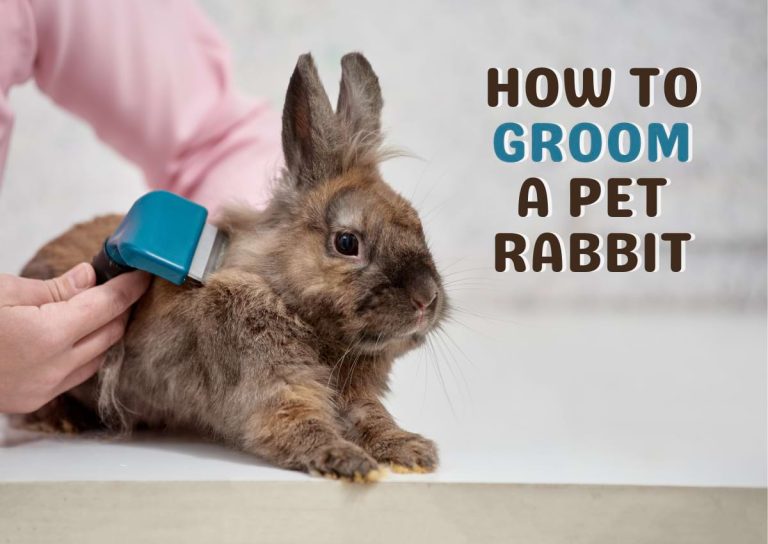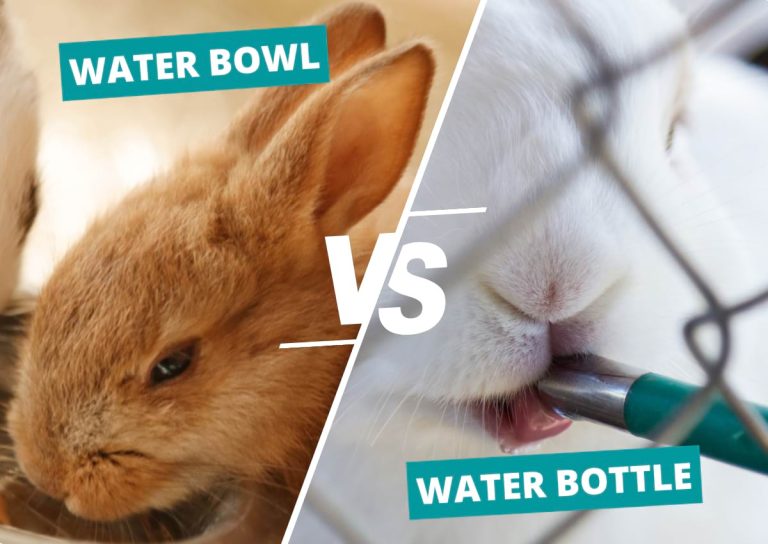Indoor Rabbit Cage Setup for Happy & Healthy Bunnies
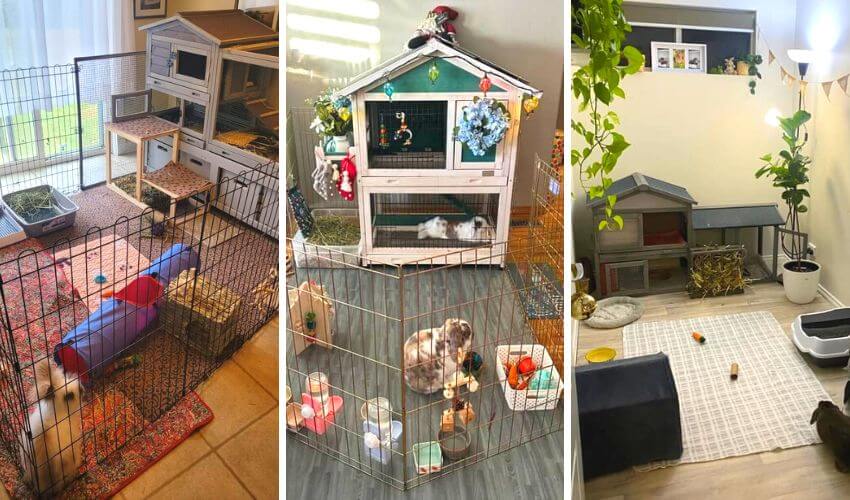
Have you adopted a new friend and want to create the best indoor rabbit cage setup you can? Are you already a fur mom and looking to upgrade your bunny to a better living situation?
Your rabbit cage setup is what your pet’s world revolves around. That means you need everything to be exactly right, from what it includes to where you put it. Rabbits can be finicky, so if you don’t set it up right, it could end in a mess!
In this article, you’ll learn what your rabbit cage setup should be like– from how big it should be to where to put it, and more. Keep reading to learn more about building the ultimate rabbit cage setup.
Proper Rabbit Cage Size
The right size truly depends on your rabbit’s breed and size. You wouldn’t need as much space for a Netherland Dwarf as you would a Flemish Giant. Either way, the cage should be big enough for your rabbit to hop around, stretch out, etc. You know, big enough to actually live inside.
According to rabbit welfare groups, the ideal cage size for a rabbit is 8-12 sq. ft. with access to exercise space of at least 24 sq. ft. That is enough space for 1 or 2 rabbits, although more is always better, especially if you have more than one rabbit.
That’s why it’s so beneficial to let them roam free around the house (provided they’re litter trained, of course). But if that’s not possible, your rabbit will need at least 5 hours of exercise in the recommended amount of space to stay healthy and happy.
What Type of Bunny Cage is Best?
Rabbits need much more room than any pet store cages can provide. So, if you can’t give your rabbit free access to your home, consider some more spacious enclosure options.
My personal favourite rabbit cage option is a puppy playpen. Puppy play pens are usually the perfect size, lightweight (but not enough to tip over), and most importantly, super-easy to keep clean.
A crate for an extra-large dog is large enough for an average-sized rabbit to live within. Plus, dog crates have a convenient plastic bottom you can slide out to clean.
Last but certainly not least, there is the option of creating your own cage with snap-on C&C grids. Not only does it let you design the perfect bunny cage setup, but it’s also relatively inexpensive.
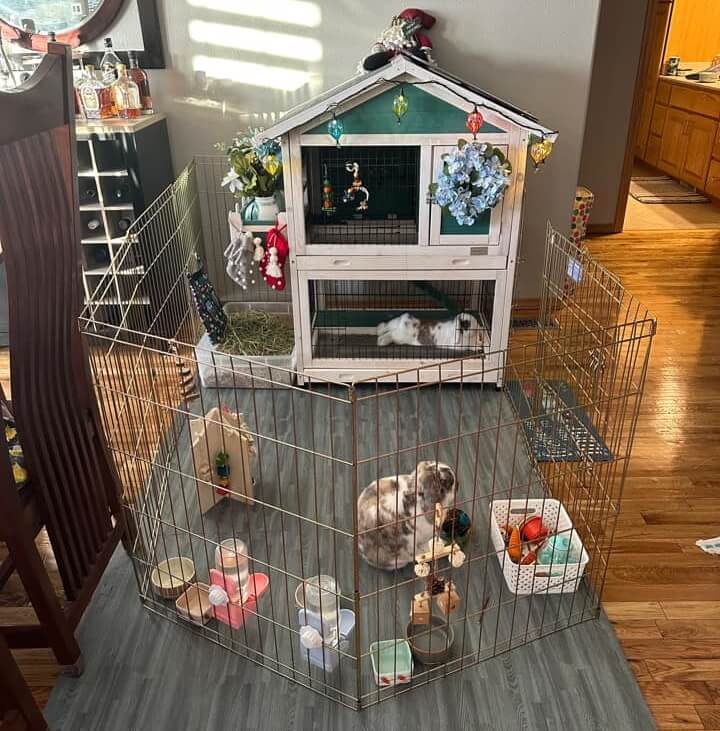
Types of Rabbit Cages to Avoid
Other than small pet store cages, there are some other things you might see recommended that are anything but good for rabbits. Here are some other enclosures you should avoid for your rabbit’s sake:
- Wire-bottom cages
- Aquariums & fish tanks
- Hutches unless there’s 24/7 access to a larger area – such as on the photo above
You can learn more about the best cages for rabbits and get some recommendations here.
Free Roam Rabbits – Is Free Roam Better?
In my experience, and that spans over many years, I truly believe that free roam is the best way to go. Rabbits that get to explore and wander their own surroundings are physically healthier, mentally healthier, and so much more.
Free-roam rabbits are typically happier and healthier rabbits. And that’s not because they get to wander around, doing whatever they want, although knowing my rabbit, I’m sure that’s an integral part.
Letting your rabbits have free roam over your home isn’t just beneficial for your rabbits either. Since you don’t need a cage, you won’t need to buy disposable bedding. After rabbit proofing, you just need the litter for the litter boxes. Plus, that makes things a heck of a lot easier when it comes to cleaning.
If your rabbit is free to roam, you’ll need a main station to host his food, litter box, and bed. We’ll get more into that in a minute.
What Do You Put on the Floor of a Bunny Cage
Of course, if your rabbits are free to roam, you won’t even need bedding. But, even in the bunny cage setups we’ve covered, traditional bedding would only lead to a big mess.
That said, you still need something to protect your floors from any accidents and messes that –make no mistake– will happen.
Instead, here are some better options for the floor of your rabbit enclosure:
- Splat mats
- Plastic tray from a large/x-large dog crate
- Whelping mats
- Bath mats
- Vinyl or linoleum flooring
- Canvas surface protection / painting sheets
- Fleece blankets or liners
- Seagrass rugs

Types of Bedding to Avoid Using
Aside from traditional bedding such as paper bedding or wood shavings (which, again, would be a complete mess and a waste of money), here are some other types of things to avoid putting on the floor of your rabbit cage:
- Thin plastic surface protection sheets
- Astro turf
- Thick carpeting
- Thin bed sheets
Where Should a Rabbit Cage or Main Station Go?
The best place for a rabbit’s enclosure or station is a peaceful room that he’s already comfortable in. That should be a room that doesn’t see the busy day-to-day activities of your life, like the loud noises of the television, kids, etc.
My rabbit, Chile, is free-roam and prefers spending most of his time in my office because it’s quiet, I’m always in there, it’s completely bunny-proofed, and no one but the cat (his best friend) ever comes in. So, this is where I keep his station setup.
Also, rabbits should never be in direct sunlight. Rabbits typically like the dark, being crepuscular and burrowing animals. However, they shouldn’t be in a cold, dark basement either.
Essential Items for a Rabbit Cage or Main Station
Once you’ve chosen the ideal type of rabbit cage and decided what to put on the floor, you need to set it up with all the necessities. Even if you’ve opted to let your rabbits be free to roam, you’ll need to equip their stations with the essentials.
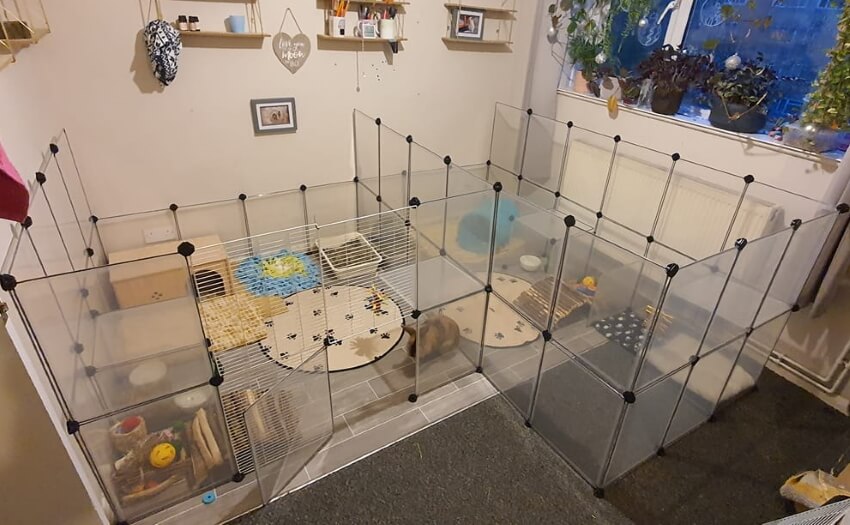
Here’s what you need to include in your bunny cage setup or main station:
- Water and food dishes
- Unlimited access to hay
- Hidey houses or tunnels
- Bed
- Litter box
- Toys
Water Bowl or Water Bottle – Which is Best?
Water bottles may seem like the best option because they’re convenient and cleaner. However, they’re not the best choice.
First and foremost, bottles don’t provide enough water flow for rabbits, so they might not drink enough to keep them hydrated. Water bottles also make your rabbit drink at an awkward angle that can hurt their neck, and, lastly, research showed that bunnies prefer using bowls over bottles.
While water dishes need more cleaning and are much more likely to spill, they are the best way to ensure your rabbit always has fresh, clean water. You can learn more about that in our post on water bottles vs water bowls for rabbits.
Hay
Hay is absolutely vital to your rabbit’s health. In fact, it makes up most of their diet. Even most pellets are made of compressed Timothy hay. But even so, your rabbits always need access to fresh hay for their digestive health.
There are many types of hay that are healthy for rabbits, all with specific health benefits. Again, your rabbit always needs access to hay, so it’s best to have it in different places. In an enclosure, you should put some by the food and some by the litter box. And, for enrichment purposes, stuff some in DIY toys.
Food Dishes
For food dishes, it’s always best to have one per rabbit. You don’t want to risk a fight, even if your rabbits get along.
In my time owning rabbits, I’ve used metal dishes, plastic dishes, and porcelain dishes, and my favourite is the porcelain option. They’re too heavy for rabbits to throw around and tip over and usually dishwasher-safe.
Hidey House or Tunnel
Rabbits are natural burrowers. And since you can’t let them start digging through the floor, you can give them a safe place to hide or hang out. There should be one per rabbit to avoid fighting.
Hidey houses and tunnels are a great way to help your rabbit feel safe in an open enclosure or keep free-roam rabbits from spending all of their time under your furniture.
Bed
Whether your rabbits are free to roam or have a sizable enclosure, they need a comfy bed to curl up in when it’s time to sleep. Again, to avoid conflict, there should be one per rabbit.
That can be anything from a cat bed to a bunched-up blanket, as long as it’s cozy, warm, and safe. If your rabbit is free-roam, make sure the bed is by his station or wherever your rabbit sleeps.
Toys
Your rabbits will need lots of toys to keep their minds occupied, even if they’re free to roam. Boredom only leads to two things in rabbits: depression and destruction.
To prevent depression and destructive chewing, your rabbit needs chew toys, puzzle toys, and interactive toys for bonding time. Get some DIY rabbit toy recommendations here.
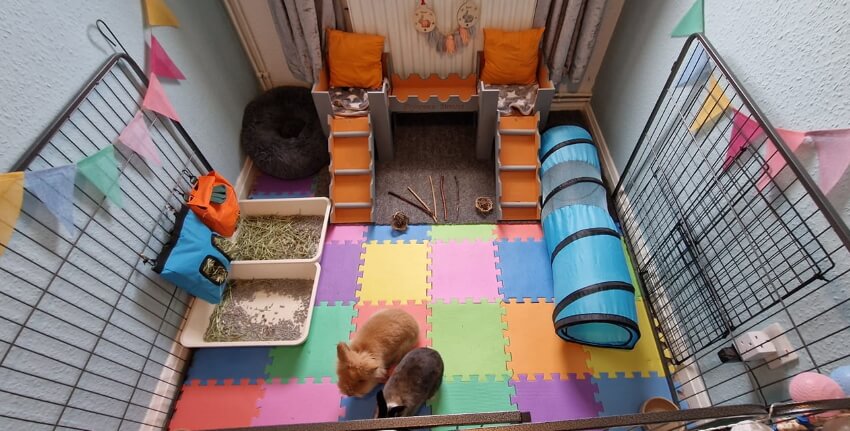
Rabbit Litter Box Setup
Now, for your rabbit’s litter box setup, you’ll need a litter box, absorbent litter, and lots of hay to encourage usage, even if your rabbit is already litter-trained. If your rabbit is a free-roaming bun, their station should be where the litter box or cage used to be, at least to start.
You can gradually move it to a better place if needed. It will just take time for your rabbit to adjust, and you may have to do a little extra cleaning in the meantime.
There are two types of litter boxes you can use. The triangular litter boxes are great for saving space in enclosures. And the square cat litter boxes are spacious enough to prevent accidents.
Both are great options. But, it’s mostly up to preference and what works best for your rabbit and the rabbit cage setup.
Best Types of Litter for a Rabbit Litter Box Setup
Just like with cages and bedding, pet stores will try to throw a bunch of different options in your face, and only a few of those will actually be good for your rabbit, let alone necessary.
Here are some good options to use in your rabbit litter box:
- Recycled paper bedding
- Recycled paper pellets
- Shredded paper
- Aspen shavings
- Kiln-dried pine pellets
Types of Litter to Avoid
Again, many of the litter or bedding types available in pet stores aren’t actually good for your rabbit. Here are some of them:
- Cedar and non-kiln-dried pine shavings
- Corn litter
- Clay-based cat litter
- Straw
- Sawdust
How to Avoid Aggression Between Rabbits With a Proper Cage Setup
When it comes to food, rabbits can get a bit touchy. If you only have one rabbit, you won’t run into this problem. But for multiple rabbits, know that food aggression is real, and can only end in two scenarios:
- A fight over food (especially between males).
- One rabbit dominates the other, which means one rabbit goes without food.
You can easily avoid this by having one of each essential item for every rabbit you have. And by keeping those things separate. It’s a little easier with free-roam rabbits since there is more space.
If aggression continues or escalates, consider fixing your rabbits. And if it doesn’t stop, they may need to be separated.
Indoor Rabbit Cage Setup Photos for Inspiration
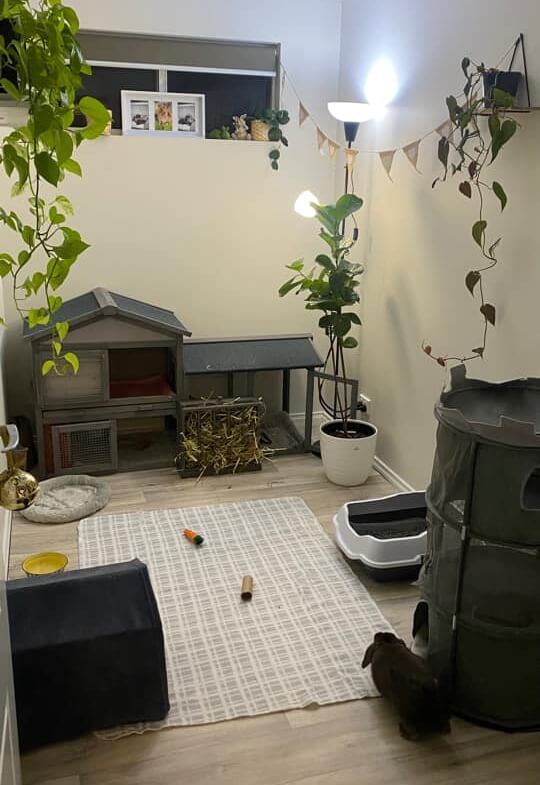 Rabbit’s main station | Image by Lucy Morriss
Rabbit’s main station | Image by Lucy Morriss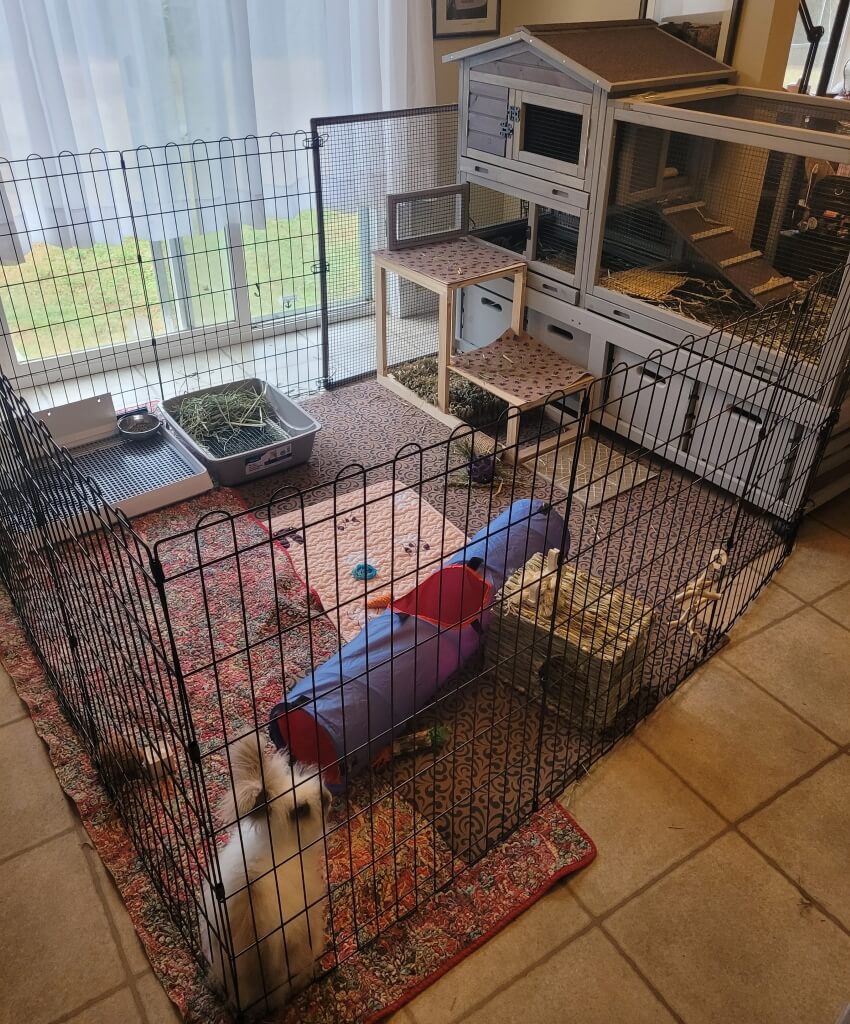 Image by: Tamlyn Heart
Image by: Tamlyn Heart Rabbit’s main station | Image by: Cindy Rogers
Rabbit’s main station | Image by: Cindy Rogers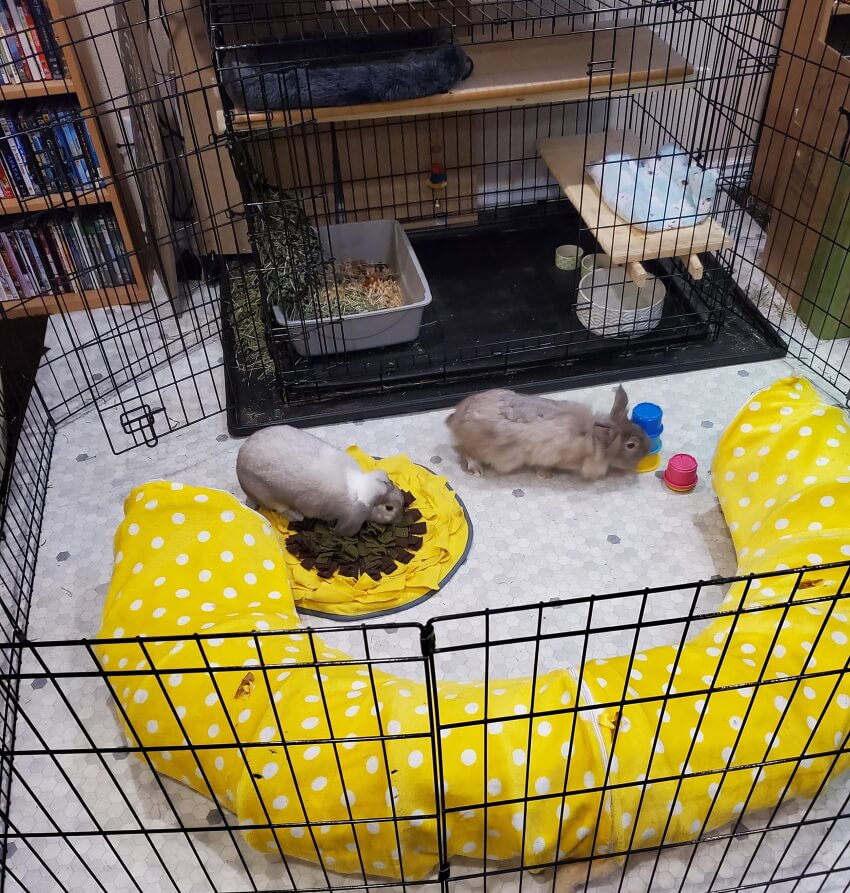 Image by: KayLyn Giles
Image by: KayLyn Giles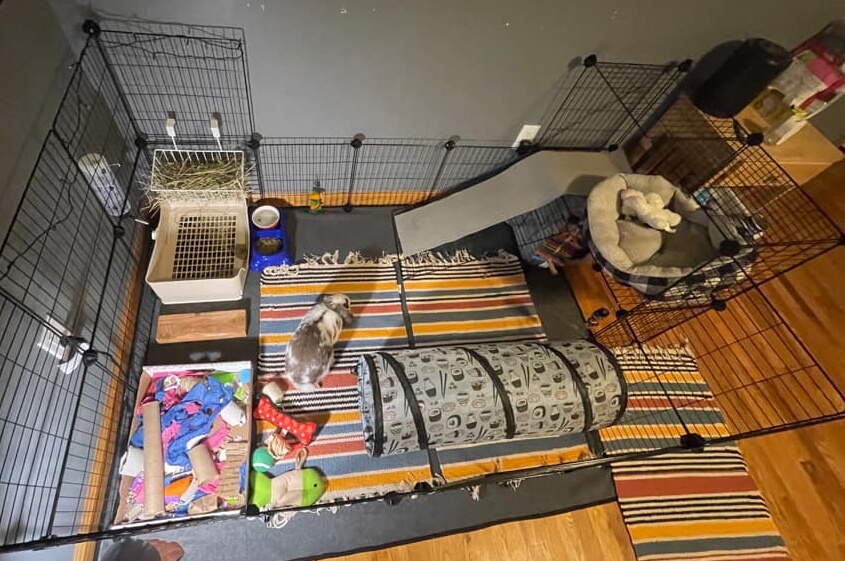 Image by: Kristina Austin
Image by: Kristina Austin
Creating a Bunny Cage Setup for a Happy, Healthy Bun
If you create your rabbit cage setup with the tips and advice I’ve given you today, I have no doubt that your rabbit will be happy and healthy. And if bonded to you, they’ll show you how much they love their “new digs.”
Rabbits don’t need a whole lot. They’re not complex like us humans. But when they have what they need, they’re the best pets that a human could ask for.

